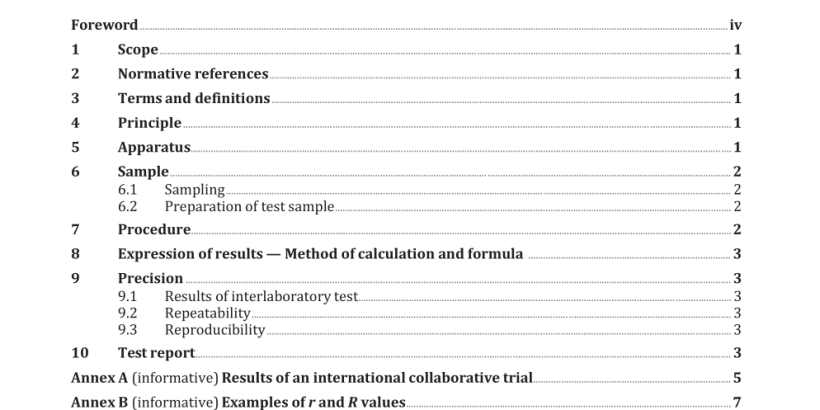ISO 771:2021 pdf download – Oilseed meals — Determination of moisture and volatile matter content.
1 Scope
This document specifies a method for the determination of the moisture and volatile matter content of
oilseed meals obtained by the extraction of oil from oilseeds by pressure and/ or solvent.
2 Normative references
The following documents are referred to in the text in such a way that some or all of their content
constitutes requirements of this document. For dated references, only the edition cited applies. For
undated references, the latest edition of the referenced document (including any amendments) applies.
ISO 5502, Oilseed residues一Preparation of test samples
3 Terms and definitions
For the purposes of this document, the following terms and definitions apply.
ISO and IEC maintain terminological databases for use in standardization at the following addresses:
ISO Online browsing platform: available at https:/ /www.ise .org/obp
IEC Electropedia: available at http://www.electropedia .orgt
4 Principle
The sample is ground to a particle size of 1 mm, followed by drying of a test portion at (103 ± 2) °C in an oven at atmospheric pressure, until practically constant mass is reached.
5 Apparatus
5.1 Analytical balance, readability 0,000 1 g, weighing precision 0,001 g.
5.2 Mechanical mill, easy to clean and allowing the meals to be ground, without heating and without appreciable change in the moisture, volatile matter and oil content, to particles passing completely through the sieve (5.3).
5.3 Sieve, with apertures of diameter 1 mm.
5.5 Electric oven, with thermostatic control and good natural ventilation, capable of being regulated so that the temperature of the air and of the shelves in the neighbourhood of the test portions lies between 101 °C and 105 °C in normal operation.
5.6 Desiccator, containing an efficient desiccant and provided with a metal plate that allows vessels (&4) to cool rapidly.
6 Sample
6.1 Sampling
Sampling is not part of the method specified in this document. A recommended sampling method is given in ISO 5500. A representative sample should have been sent to the laboratory. It should not have been damaged or changed during transport or storage.
6.2 Preparation of test sample
Prepare the test sample in accordance with ISO 5502. Grind the contract sample in the previously well- cleaned mechanical mill (), collect the grindings, mix carefully and carry out the analysis without delay.
7 Procedure
7.1 Carry out two determinations on each sample.
7.2 Weigh the vessel to the nearest 0,00 1 g with the lid (4), after leaving it open for at least 30 mm in the desiccator (&.6) at laboratory temperature. Note mass mo.
7.3 Weigh, to the nearest 0,001 g, about 5 g of the test sample into the vessel (&4), spread the sample uniformly over the whole base of the vessel, and re-weigh with its lid. Carry out these operations as quickly as possible, in order to avoid any appreciable change in moisture content. Note mass mi.
7.4 Place the vessel with the test portion in the oven (&), which has previously been set to a temperature of (103 ± 2) °C, and take off the lid.
If several vessels are in the oven together, arrange them in such a way that air can circulate freely between them.
7.5 Close the oven. After 2 h, reckoned from the time when the temperature in the oven has returned to (103 ± 2) °C, open the oven, replace the lid on the vessel before removal from the oven and transfer to the desiccator. As soon as the vessel has cooled to laboratory temperature, weigh it to the nearest 0,001 g.
During the drying, do not open the oven to add other test portions.
7.6 Return the vessel, with the lid removed, to the oven. After 1 h, repeat the operations of closing the vessel, allowing to cool, and weighing. Note Mass m.
7.7 If the difference between the two weighings is equal to or less than 0,005g. regard the determination as finished. If not, repeat the procedure and dry again for 1 h in the oven, until the difference between two successive weighings is equal to or less than 0,005 g.
NOTE For most oilseed meals, a single 4 h period in the oven at (103 ± 2) °C gives equivalent results, but it is the responsibility of the analyst to confirm this in each particular case.
